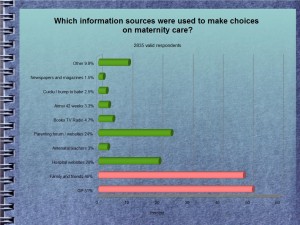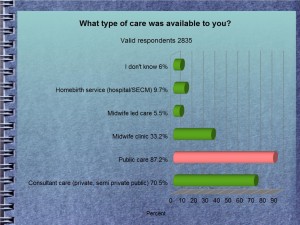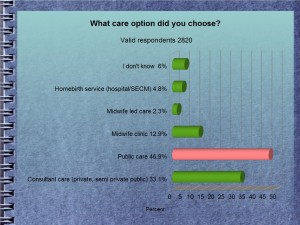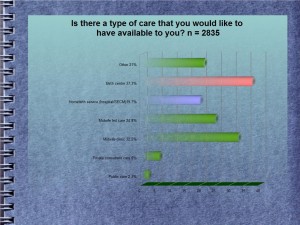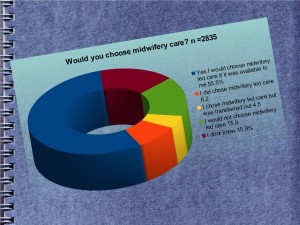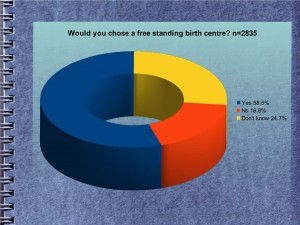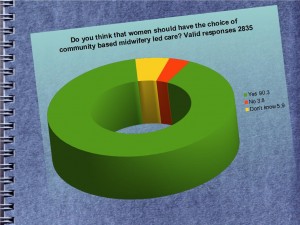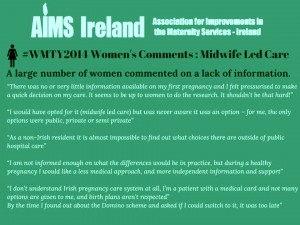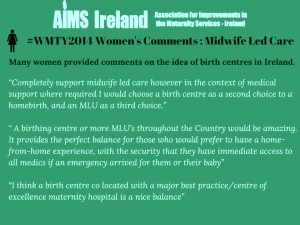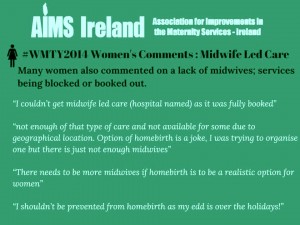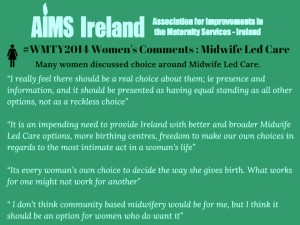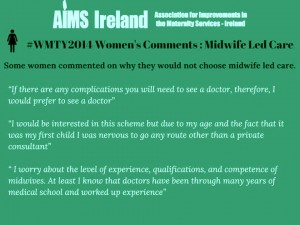Survey: Maternity Care Choices in Ireland
What were the choices available to women in terms of maternity care in Ireland and what did they think of them?
This discussion is based on the AIMSI What Matters To You survey results of 2014 -2015.
In spring of 2014 AIMS Ireland ran an electronic survey on the topic of “What Matters to YOU?”. It was available through the AIMSI website (www.aimsireland.ie), AIMS Ireland social media, parenting pages, and was also shared widely through social media channels (twitter and facebook groups), and Irish Health.com.
This section of the survey focused on the decisions that a woman and her family have to make near the start of her pregnancy; namely who is she going to choose as her care provider. The survey looked at how women make the choice, what information they use to make the choice and what choices are actually available to them.
Executive summary
1. Current availability of midwifery led care
Only 5.5% of respondents stated that midwifery led care was currently available to them.
2. Desire for midwifery led care
Of those that did not have midwifery care available, 24.8% said they would like to have a midwifery led service (on the lines of MLU/ DOMINO) available to them
Of those that did not currently have midwifery led care available, 55.5% said they would choose midwifery led service (on lines of MLU/ DOMINO) if it was available to them
3. Desire for homebirth services
Of those that did not currently have a homebirth service available to them, 19.7% said they would like to have homebirth service available to them.
4. Desire for birth centres
91.7% of respondents said that women in general should have the choice of a freestanding birth centre
58.5% of respondents said that they would personally choose a free standing birth centre if it were available
5. Desire for community based midwifery led care
90.3% of respondents said that women in general should have the choice of community based midwifery led care
42.6% of respondents said they would personally choose community based midwifery led care if it were available to them
Midwife-led care has been defined by the Royal College of Obstetricians and Gynaecologists (2001) as care where: ‘the midwife is the lead professional in the planning, organisation and delivery of care given to a woman from initial booking to the postnatal period’.
Results of Maternity Care Choices in WMTY 2014
Q6. How do you rate the availability of information on all the care options in Ireland? (e.g. public, private, semi-private, MLU, Homebirth.) Valid responses 2835
The majority of respondents rated information on care options as fair, with a further 27% rating it as poor and 28% rating it as good. 8% said available information was very poor and 6% said it was excellent
Table 1. Rating of the availability of information on all the care options in Ireland
| Rating | Percentage |
| Excellent | 6.00% |
| Good | 20.00% |
| Fair | 31.70% |
| Poor | 27.00% |
| Very poor | 8.00% |
Valid responses 2835
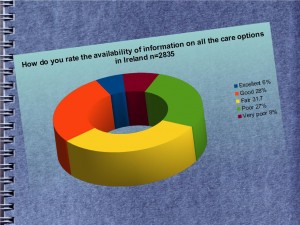
Figure 1. How women rate the availability of information in making a choice re maternity care provider
More than one in four respondents rated the information on maternity care provider as “poor”, and when this is combined with the “fair” rating of 31.7%, we can see that over half of the respondents felt that the availability of information on which to make a decision was sub optimal. Most women make their decisions based on information from their GP, from the internet and from friends and family. Out of these the GP is the traditional gatekeeper to information. Many respondents reported in their comments that their GP did not tell them that there were choices about care, and that most GPs focused on the choice between public semi private and public care rather than on the different type of caregiver or care model.
Q7 Which information sources were used to make choices on maternity care. Multiple choices. Valid respondents 2835
As mentioned above the main gatekeeper for information appears to be the GP; as this information source was used by 51%, family and friends were the next most influential source of information and used by 46% of respondents. Hospital websites accounted for 20%, antenatal teachers for 3%, parenting fora and websites 24% books, TV, radio 4.7% AIMSI publications and 42weeks 3.3% Cuidiu publications and bumptobabe 2.5%, newspapers or magazines 1.5%.
Table 2. Information sources used to make choices about maternity care provider
| Source | Percentage 2014 | Percentage 2010 |
| GP | 51.00% | 22.60% |
| Family and friends | 46.00% | 26.40% |
| Hospital websites | 20.00% | NA |
| Antenatal teachers | 3.00% | NA |
| Parenting forum / websites | 24.00% | 26.40% |
| Books TV Radio | 4.70% | NA |
| Aimsi 42 weeks | 3.30% | NA |
| Cuidiu / bump to babe | 2.50% | NA |
| Newspapers and magazines | 1.50% | NA |
| Other | 9.90% | 4.00% |
| Personal experince | NA | 20.70% |
Valid respondents 2835
It would appear that respondents are seeking information from a much wider variety of sources than in 2010, with hospital websites featuring quite highly for the first time. In written comments respondents mentioned that they would have liked to see more information related to care policies and policies during labour. However, the GP still remains the key gatekeeper to information on maternity care options, and yet respondents also reported that the information they received from their GP was often limited sometimes out of date and not comprehensive. Respondents particularly reported problems with getting information about home birth from their GP. Many respondents stated that their GP had a very particular personal view about home birth and about other midwifery led care options where they were available. The increase in information source consulted however indicates that respondents are hungry for information and are actively trying to find out more about their options.
Q8. What type of care was available to you? Valid respondents 2835
The most frequently cited care available was public care (87.2%) followed by consultant led care, either public private or semi public (70.5%). Midwife clinics (but not midwifery led clinics) were substantially less available, with only 33.2% of respondents citing it as a care option available to them. Midwifery led care and home birth options were noticeably less available at less than 10% each.
Table 3. Type of care available
| Type of care available | Percentage |
| Consultant care (private, semi private public) | 70.50% |
| Public care | 87.20% |
| Midwife clinic | 33.20% |
| Midwife led care | 5.50% |
| Homebirth service (hospital/SECM) | 9.70% |
| I don’t know what care options were available | 6.00% |
Valid respondents 2835
Given that the research shows us that most women will fare better with midwifery led options than with consultant led options, it is worrying to see so few respondents citing this option as available to them. It is surprising to see that there appears to be even more homebirth options available than midwifery led options. This is probably partly due to the availability of homebirth in the NMH. The lack of midwifery led units and midwifery led care options is however stark and in direct contrast to options available to mothers in the UK where 99% of women have access to both an obstetric-led unit and a midwife-led unit within a 60 minute drive of their home.
Q9. What care option did you chose? Valid respondents 2820
The majority of respondents chose either consultant led care (33.1%) or public care (46.9%) . Just over 12% chose a midwifery clinic, but only 2.3% were able to chose midwifery led care. Nearly 5% of the population chose home birth with midwives working independently or within a hospital setting.
Table 4. Type of care chosen
| Type of care available | Percentage |
| Consultant care (private, semi private public) | 33.10% |
| Public care | 46.90% |
| Midwife clinic | 12.90% |
| Midwife led care | 2.30% |
| Homebirth service (hospital/SECM) | 4.80% |
| I don’t know what care options were available | 6.00% |
Valid respondents 2820
Women’s choice of care provision will be determined by the level of provision associated with that model of care. In Ireland, the majority of care is provided by the consultant led model of care with women either opting for public private or semi private care depending on whether they have insurance or not. Essentially, women do not have a choice in terms of care model in Ireland. If choices in care model such as midwifery led units are available there are not equitable geographically, and certain areas of the country will have no choices in care provision. For most areas the choice is obstetric led care or home birth care. This is an extremely polarised choice for most women, especially women on their first baby, who may not want to attend a unit where they will more than likely be subject to a lot of interventions, yet on the other hand find the thought of a homebirth too radical.
Q10. Is there a type of care you would like to have available to you? Valid respondents 2835 multiple answers.
The most popular types of care that respondents wanted to see made available were birth centres (37.3%) followed by midwifery clinics (32.5%) midwifery-led care (24.8%) and homebirth care (19.7%).
Table 5. Type of care women would like to avail of that is not currently available.
| Type of care available | Percentage |
| Consultant care (private, semi private public) | 8.00% |
| Public care | 2.30% |
| Midwife clinic | 32.50% |
| Midwife led care | 24.80% |
| Homebirth service (hospital/SECM) | 19.70% |
| Birth Centre | 37.30% |
| Other | 21.00% |
Valid respondents 2835 multiple answers possible
Respondents were keen to see alternative forms of care available involving midwives. In particular respondents were interested in seeing more birth centres being made available. This is probably partly due to the prevalence of birth centres in the British model which are frequently discussed in the digital media and the internet. Women were also interested in other types of midwifery based care, both in ad out of the community setting.
Q11. Midwifery care choices valid responses 2835
Two out of three respondents indicated that they would chose midwifery care if it were available to them; 55% did not currently have the option of midwifery led care, but would chose it as an option if it were offered and another13% percent did choose midwifery care as it was offered to them as an option. 15.8% of respondents would not choose midwifery led care and a further 15.% was undecided.
Table 6. Choices women would make in respect of midwifery care
| Type of care | Percentage |
| Yes I would choose midwifery led care if it was available to me | 55.00% |
| I did chose midwifery led care | 8.20% |
| I chose midwifery led care but was transferred out | 4.50% |
| I would not choose midwifery led care | 15.80% |
| I don’t know | 15.90% |
Valid responses 2835
This aspect of the survey indicates that over half of the respondents are currently opting for a model of care that they would forgo for midwifery led care if midwifery led care was an option for them. It indicates that a large cohort of respondents were not currently receiving their preferred choice of care in the Irish maternity system.
Q12. Do you think that women should have the choice of freestanding birth centers? Valid responses 2835
The overwhelming majority of respondents (91.7%) indicated that freestanding birth centers should be available as a choice to women in the Irish maternity system. Only 1.8% of respondents felt these should not be an option with 6.5% undecided.
Table 7. Proportion of women who believe that there should be the choice of a freestanding birth centre available
| Opinion | Percentage |
| Yes | 91.70% |
| No | 1.80% |
| Don’t know | 6.50% |
Valid responses 2835
Ireland currently has no freestanding birth centres. The overwhelming response to this question indicates that respondents felt freestanding birth centres are a vitally important component of a maternity service.
Q13. Would you choose a freestanding birth centre? Valid responses 2835
Over half of respondents (58.5%) indicated that they would choose a freestanding birth centre if one were available, 24% said that they were undecided and 16.8% said that they would not choose this model of care.
Table 8. Proportions of respondents who would choose a freestanding birth centre
| Opinion | Percentage |
| Yes | 58.50% |
| No | 16.80% |
| Don’t know | 24.70% |
Valid responses 2835
The response to this question is interesting as it shows that whilst respondents may have felt that a freestanding birth centre should be available as a choice for women (see previous question), they wouldn’t necessarily choose it themselves. None the less, the response to this question indicates the strong positive demand that exists amongst service users for freestanding birth centres, as one in two women would use them.
Q14. Do you think that women should have the choice of community based midwifery led care? Valid responses 2835
As with the previous set of questions on freestanding birth centres, the overwhelming majority of respondents (90.3%) felt that community midwifery services should be made available to women, with 5.9% undecided and 3.8% saying no.
Table 9. Opinions on whether women should have the choice of community based midwifery care
| Opinion | Percentage |
| Yes | 90.30% |
| No | 3.80% |
| Don’t know | 5.90% |
Valid responses 2835
There was a unified call from respondents for more community based midwifery care. This type of care includes care in the community from a team of midwives, caseload midwifery or independent midwives and can include antenatal care, home birth and postpartum care options such as early transfer home.
Q15. Would you choose community based midwifery led care if it were an option? Valid responses 2835
Nearly half of respondents (42/%) indicated that they would choose community based midwifery led care, with another 10% stating that they had chosen community based midwifery led care. Just over a quarter of respondents, (28.6%) said that they would not choose this model of care and 19.3% were undecided.
Table 10. Respondent’s opinions on the choice of community based midwifery led care.
| Opinion | Percentage |
| Yes, I would choose community based midwife led care options? (homebirth scheme/homebirth with a SECM) | 42.60% |
| Yes, I did choose community based midwife led care options and my birth was attended by the community midwives | 6.30% |
| Yes, I did choose community based midwife ed care but I was eventually transferred to obstetric led care(in hosital) | 3.20% |
| No, I would not choose community based midwife led care | 28.60% |
| I don’t know | 19.30% |
Valid responses 2835
We often hear in the media that women don’t want or are not interested in community based midwifery. We hear that the reason that there are so few home births is because the demand just isn’t there. Hopefully the response to this question from 2835 respondents will indicate the interest in these models of care to decision makers and policy makers.
Qualitative Responses
Conclusions
The desire for midwifery led care amongst maternity care service users in Ireland is much higher than the current provision of such care. The new Maternity Strategy for Ireland takes on board this view and has recommended an alongside birth centre for every maternity unit in Ireland. It is expected these alongside birth centres will be run along the lines of MLUs, with the midwife being the lead carer.
Read more on the National Maternity Strategy for Ireland 2016-2026
For a review of choices in the maternity services in Ireland go to http://aimsireland.ie/choice-in-pregnancy-and-birth-in-ireland/
More on maternity care options here
 AIMS Ireland
AIMS Ireland